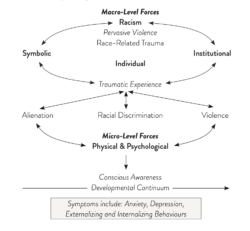A Framework for Race-Related Trauma in the Public Education System and Implications on Health for Black Youth
4 years ago 4 years agoYouthREX Research Summaries ask Just Six Questions of research publications on key youth issues. These summaries get at what the youth sector needs to know in two pages or less!
1. What was this research about?
Racism includes both micro-level (i.e., individual interactions) and macro-level (i.e., institutional structures and symbols) forces that disrupt the wellbeing of racialized youth. Race-related trauma is “an adverse interaction, either continuously or daily, with institutional, symbolic, and individual acts of racism” (p. 927). Few studies examine racism as a form of trauma, especially in the public education system.
This research proposes a framework that aims to (1) increase the understanding of race-related trauma, (2) recognize micro-level and macro-level forces of racism, and (3) understand how damaging alienation, discrimination, and violence can be for Black youth in the public education system.
2. Where did the research take place?
The research draws on American literature in education, social sciences, and public health.
3. Who is this research about?
This research is about Black youth in the United States. Based on a number of mental health indicators, including depression, anxiety, and suicide rates, this population represents one of the most vulnerable groups in the United States. Compared to their peers, and as a result of race-related trauma, Black youth are also more likely to be suspended, to be placed in special education programs, and to become involved with the juvenile justice system.
“Mitigating race-related trauma begins by building a school culture that values the cultural realities of racially diverse youth, entails transparent practices, and integrates families and community members in governance and decision-making” (p. 931).
4. How was this research done?
The authors conducted a literature review in order to examine the impacts of alienation, racial discrimination, and violence in the public education system on the wellbeing of Black youth. The review also aimed to draw connections between micro-level and macro-level forces of racism, and the academic and health outcomes of Black youth.
5. What are the key findings?
Based on their findings, the authors developed a framework for race-related trauma in the public education system (Figure 1.), which demonstrates the interplay between micro-level and macro-level forces of racism. The framework suggests that macro-level forces contribute to the devaluation of racially diverse populations, while micro-level forces result in more direct psychological and physical harm through alienation, discrimination, and violence.
Figure 1. A Framework for Race-Related Trauma in the Public Education System

This framework can reveal causal links between micro-level and macro-level forces of racism, and their effects on the wellbeing of Black youth in the public education system. While the framework may help identify the presence of race-related trauma, solutions must begin with improvements in a school’s cultural climate, such as:
- Training educators and school staff to be able to meet diverse needs of youth
- Implementing collaborative and restorative practices with families and communities
- Challenging policies and procedures that exclude Black youth
An inclusive school climate is one that values the cultural realities of diverse youth, promotes transparency, and engages families and community members in governance and decision-making.
For example, this framework can be used to change school suspension policies by (1) promoting collaborative and restorative practices, (2) implementing de-escalation strategies, and (3) improving representation and cultural responsiveness (see p. 930-931).
6. Why does it matter for youth work?
This framework can be an important tool in understanding and responding to anti-Black racism in a public education system. The authors note that economic challenges and staff turnover may pose an obstacle to the design and implementation of effective intervention strategies in schools. Instead of relying on economic resources, then, the authors argue that schools should focus on first changing the school climate and culture.
This framework is highly transferable to other settings across the youth sector, such as youth organizations and agencies. Practitioners can use this framework to identify and address the impacts of race-related trauma, and to develop interventions that promote the wellbeing of Black and other racialized youth.
Henderson, D. X., Walker, L., Barnes, R. R., Lunsford, A., Edwards, C., & Clark, C. (2019). A framework for race-related trauma in the public education system and implications on health for Black youth. Journal of School Health, 89(11), 926-933.
No gallery image found.
Categorised in: Research Summary
